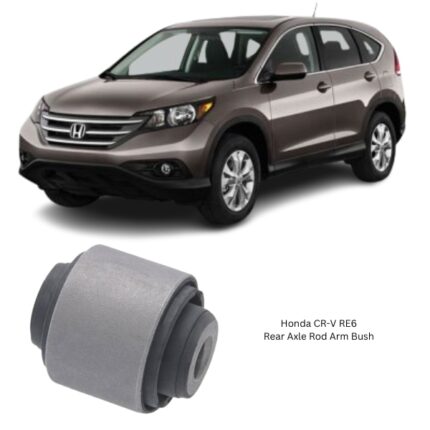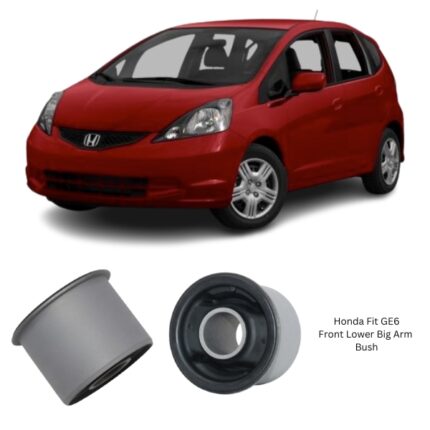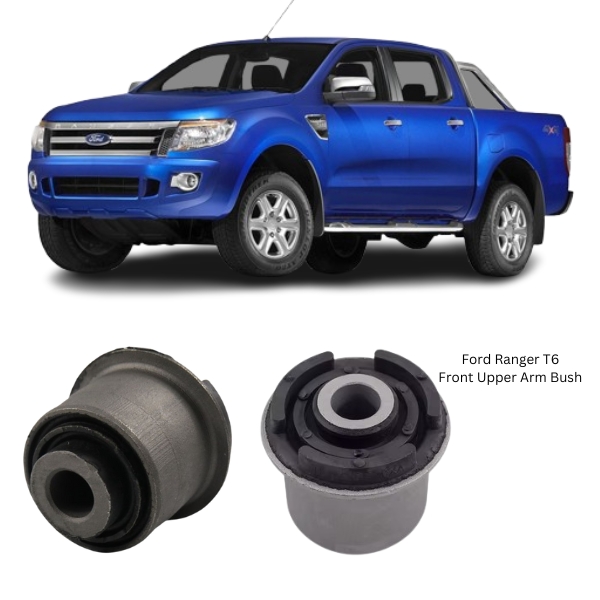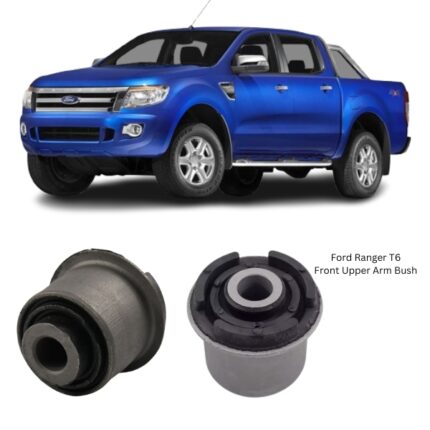Get Ford Ranger T6 Front Upper Arm Bush AB31-3068-BB in Kenya
The Front Upper Arm Bush is an essential component of a vehicle’s front suspension system. Though compact in design, it plays a critical role in maintaining proper suspension geometry, enabling smooth control arm movement, and ensuring the overall integrity of steering and handling performance.
Positioned within the upper control arm assembly, the front upper arm bush functions as a flexible joint between the control arm and the vehicle’s frame or subframe. It supports suspension movement while isolating the chassis from vibration, shock, and noise generated by uneven road surfaces. These characteristics make the bush vital not just for ride comfort, but for vehicle stability and safety as well.
Purpose and Function
The primary role of the Front Upper Arm Bush is to provide a pivot point for the front upper control arm, allowing it to articulate in response to changes in terrain or steering inputs. At the same time, it holds the arm in place, preserving correct alignment and reducing excess play that would compromise control and comfort.
Key Functions Include:
-
Suspension Flexibility
Facilitates controlled movement of the upper arm as the suspension travels, without introducing slop or instability. -
Alignment Preservation
Maintains caster and camber angles by keeping the control arm’s position fixed relative to the chassis. -
Vibration Dampening
Absorbs and isolates vibrations and road noise, improving ride comfort and cabin quietness. -
Impact Absorption
Cushions minor road shocks to reduce stress on the chassis and other suspension components. -
Noise Reduction
Prevents metal-on-metal contact within the suspension arm mountings, eliminating creaks and clunks.
Whether in normal driving conditions or under dynamic loads such as turning, braking, and cornering, the upper arm bush ensures the control arm operates smoothly and with the intended level of resistance.
Design and Construction
The Front Upper Arm Bush is a bonded component made of durable materials engineered to balance stiffness and elasticity. It is designed to endure frequent motion, high loads, and challenging environmental conditions.
Standard Components:
-
Outer Shell (Sleeve)
Typically constructed from steel or aluminum, this outer casing secures the bush inside the control arm housing. -
Elastomeric Core (Rubber or Polyurethane)
Sandwiched between the inner and outer sleeves, this flexible material absorbs motion and returns to its original shape after flexing. Rubber offers comfort, while polyurethane offers more performance-oriented stiffness. -
Inner Sleeve
A metal insert that fits around the mounting bolt and allows for secure attachment to the chassis or suspension frame. -
Void Patterns or Cut-Outs (Optional)
Some bushes are engineered with directional voids to allow different flex rates in vertical vs. horizontal directions.
Material Characteristics:
-
Rubber – Provides excellent noise suppression, shock absorption, and ride comfort. Common in OEM applications.
-
Polyurethane – Offers increased durability, reduced deflection, and higher performance, often preferred in heavy-duty or performance settings.
Together, these elements make the bush capable of supporting thousands of suspension cycles while resisting compression, fatigue, and environmental wear.
Performance Characteristics
A high-quality Front Upper Arm Bush contributes to overall vehicle performance through:
-
Consistent Steering Geometry
By maintaining fixed arm positions, it helps ensure predictable cornering, especially under load. -
Load Distribution
Transmits braking, cornering, and road forces from the wheels to the chassis without allowing disruptive deflection. -
Long-Term Durability
Engineered to resist tearing, cracking, or delamination under continuous stress and varied temperatures. -
Noise, Vibration, and Harshness (NVH) Control
Helps isolate unwanted movement and feedback from the suspension system. -
Corrosion and Wear Resistance
Coatings and material treatments protect the metal sleeves from rust, oxidation, and chemical degradation.
Bushes that meet or exceed original equipment standards deliver dependable performance in all road conditions, contributing to safety and comfort.
Symptoms of Wear or Failure
Like all rubber-based suspension components, the Front Upper Arm Bush deteriorates over time due to environmental exposure, mechanical fatigue, and repeated motion.
Common Signs of a Worn Bush:
-
Clunking Noises
Audible knocks or clunks from the upper control arm area, especially when driving over bumps. -
Loose or Vague Steering Feel
Increased play or imprecise steering feedback, particularly during cornering or braking. -
Uneven or Rapid Tire Wear
Misalignment caused by a worn bush can cause inner or outer tire edge wear. -
Vibration Through Steering or Chassis
With compromised damping, vibrations from the road reach the steering column or cabin. -
Visual Deterioration
Cracks, dry rot, separation of the rubber from the sleeve, or completely deformed bushings visible on inspection. -
Vehicle Pulling or Poor Handling
Worn bushings can cause the vehicle to drift or feel unstable at higher speeds.
If these symptoms are present, inspection and prompt replacement are essential to maintain suspension integrity and driving safety.
Installation Process
Replacing a Front Upper Arm Bush typically involves removing the upper control arm and pressing the old bushing out. It requires precision and may need specific tools for proper pressing and alignment.
General Procedure:
-
Lift and Secure the Vehicle
Use jack stands or a hoist to safely elevate and support the vehicle. -
Remove Wheel and Components
Detach the front wheel and disconnect any suspension parts obstructing access to the upper arm. -
Remove the Upper Control Arm
Unbolt the arm from the chassis and spindle. -
Press Out the Worn Bushing
Use a hydraulic press or bushing removal tool to remove the old component without damaging the arm. -
Install the New Bushing
Press the new bushing into place, ensuring proper orientation and seating. -
Reassemble and Torque Bolts
Reinstall the control arm and all hardware, torquing fasteners to manufacturer specifications. -
Alignment Check
Perform a full suspension alignment to ensure caster, camber, and toe settings are restored.
Professional installation is recommended for best results, especially in precision suspension systems.
Maintenance and Inspection
The Front Upper Arm Bush should be inspected during:
-
Suspension overhauls
-
Shock or spring replacement
-
Wheel alignment procedures
-
Tire rotation or brake service
-
After accidents or hard curb impacts
Timely inspection and proactive replacement can prevent further damage to the suspension and steering components.
Benefits of Timely Replacement
-
Improved Steering Accuracy – Restores precise feedback and cornering stability.
-
Enhanced Comfort – Reduces cabin vibration and harshness.
-
Better Tire Longevity – Maintains proper alignment for even tread wear.
-
Increased Safety – Ensures suspension control under braking and load changes.
-
Prolonged Suspension Life – Reduces strain on ball joints, shocks, and related parts.
Follow us on Facebook for more parts.





Reviews
Clear filtersThere are no reviews yet.